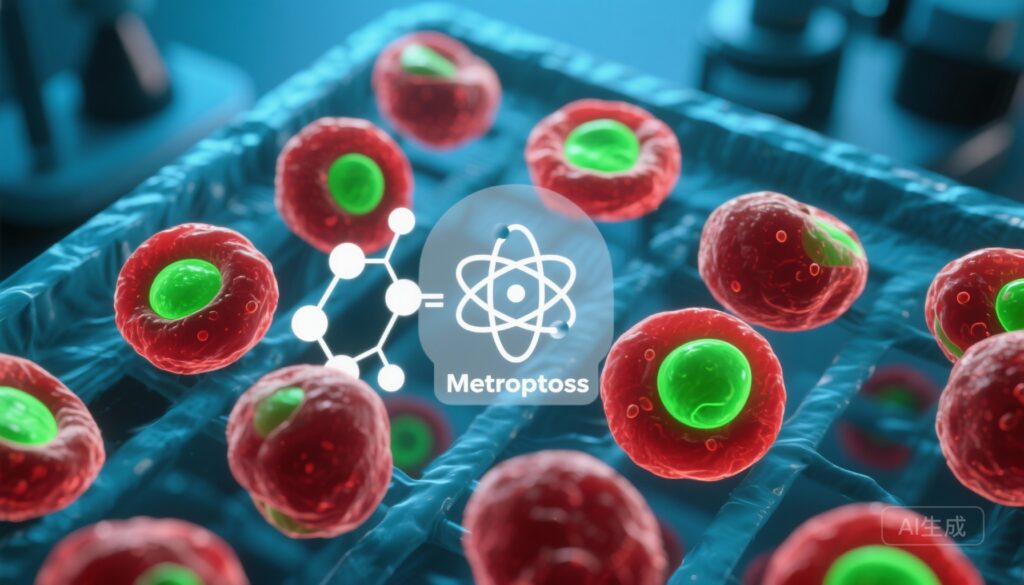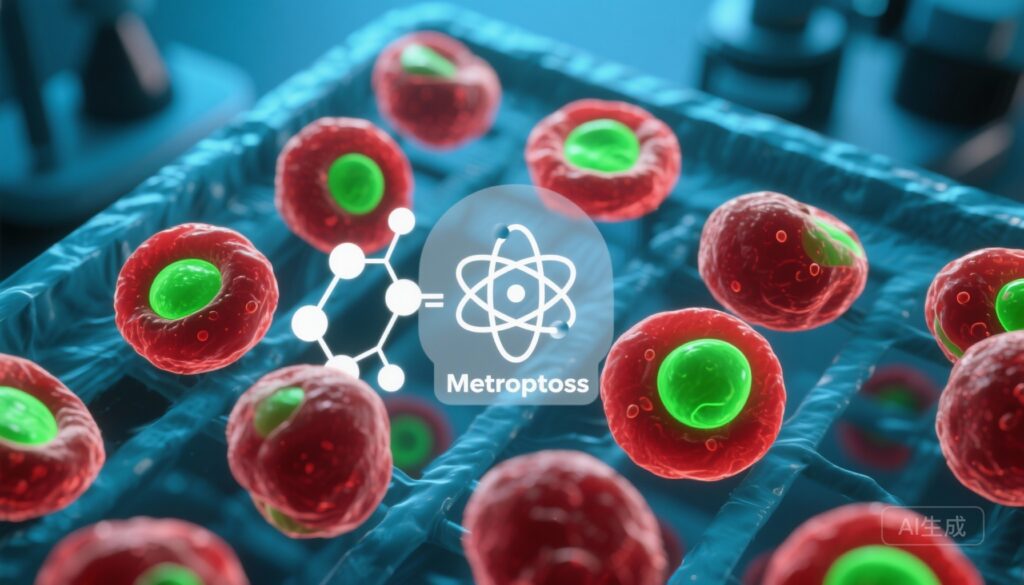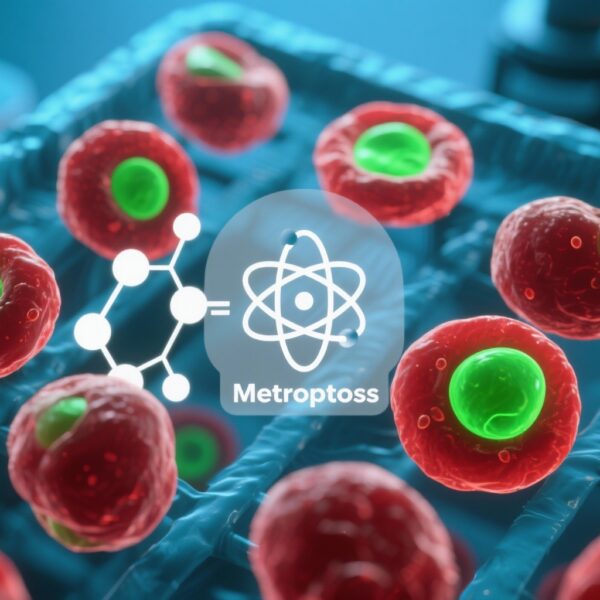Nhấn mạnh
– Metformin gây ra các loài phản ứng oxy (ROS) và cái chết tế bào ferroptosis trong các mẫu AML cấp tính in vitro, với hiệu quả lớn nhất ở các trường hợp có chuyển hóa lipid bị gián đoạn (đặc biệt là bệnh đột biến IDH2 và FLT3).
– Việc tái cấu trúc lipid với tăng triglycerides và axit béo đa không no (PUFAs), điều hòa tăng các gen hạt lipid bao gồm DGAT1, và sự hấp thụ thông qua CD36 là những yếu tố quyết định chính của độ nhạy cảm đối với metformin.
– Sự ức chế DGAT1 tạo ra sự hiệp đồng với metformin; các chất chelate sắt làm giảm tác dụng của nó—ủng hộ ferroptosis là cơ chế cái chết tế bào hoạt động và chỉ ra các chiến lược kết hợp hợp lý.
Nền tảng
Sự lập trình chuyển hóa là một đặc điểm nổi bật của ung thư và là một điểm yếu điều trị được nhận biết trong bệnh bạch cầu cấp tính myeloid (AML). Nhiều tế bào AML và tế bào gốc bạch cầu ác tính phụ thuộc vào phosphoryl hóa oxi hóa (OXPHOS) để duy trì sự sống sót và khả năng kháng hóa chất, và việc nhắm mục tiêu vào chuyển hóa ty thể đã trở thành một chiến lược hứa hẹn trong các nghiên cứu tiền lâm sàng.[3] Tuy nhiên, nhiều chất ức chế OXPHOS mạnh mẽ có độc tính liều lượng hạn chế cản trở việc chuyển đổi lâm sàng. Metformin, một loại thuốc chống tiểu đường được sử dụng rộng rãi và an toàn, ức chế phức hợp I của ty thể và giảm OXPHOS ở nồng độ dược lý và cao hơn. Sự quan tâm đến việc tái sử dụng metformin trong điều trị ung thư dựa trên hồ sơ an toàn của nó và các tác dụng chuyển hóa đa dạng, nhưng cơ chế hoạt động chống bạch cầu và dấu hiệu sinh học dự đoán đáp ứng chưa được xác định đầy đủ.
Thiết kế nghiên cứu
Nghiên cứu của Sternadt và cộng sự (Blood Advances, 2025)[1] điều tra độ nhạy cảm của metformin trên một bảng mẫu AML nguyên phát đa dạng về mặt di truyền. Các nhà nghiên cứu cô lập các tế bào CD34+/CD117+ từ các mẫu lâm sàng và áp dụng proteomics định lượng không nhãn. Họ thực hiện phân tích phong phú tập hợp gen đơn mẫu (ssGSEA) tập trung vào các đường dẫn chuyển hóa và liên kết các điểm số phong phú với độ nhạy cảm của metformin in vitro. Các thử nghiệm chức năng đo lường các loài phản ứng oxy (ROS), chế độ cái chết tế bào, và tác động của việc thao tác lipid. Phân tích lipidomic đánh giá sự thay đổi axit béo và triglycerides sau khi điều trị. Các biến đổi di truyền (giảm biểu hiện CD36) và các chất điều chỉnh dược lý (palmitate, ức chế DGAT1, chất chelate sắt) được sử dụng để phân tích cơ chế và sự hiệp đồng.
Kết quả chính
Báo cáo kết hợp proteomics, các thử nghiệm chức năng, và lipidomics để tạo ra một câu chuyện cơ chế đồng nhất. Các kết quả chính là:
1. Metformin kích hoạt sự tạo ROS và ferroptosis trong AML in vitro
Điều trị metformin in vitro tăng cường ROS tế bào và gây ra một hình thức cái chết tế bào không phải apoptosis, phụ thuộc vào sắt, phù hợp với ferroptosis. Ferroptosis được đặc trưng bởi sự peroxid hóa lipid phụ thuộc vào sắt và khác biệt với apoptosis và necroptosis.[2] Sự cái chết tế bào được giảm nhẹ bởi việc chelate sắt, xác nhận sự phụ thuộc vào sắt, và bằng các can thiệp hạn chế sự peroxid hóa lipid—ủng hộ ferroptosis là cơ chế chính.
2. Độ nhạy cảm tương quan với chuyển hóa lipid bị gián đoạn và các kiểu gen cụ thể
Chữ ký proteomics và ssGSEA cho thấy các mẫu AML có các đường dẫn chuyển hóa lipid phong phú hơn nhạy cảm hơn với metformin. Các mẫu đột biến IDH2 và FLT3 đặc biệt nhạy cảm. Các đột biến IDH được biết là làm thay đổi chuyển hóa tế bào và cân bằng oxi hóa khử thông qua việc sản xuất oncometabolite 2-hydroxyglutarate, có thể ảnh hưởng đến NADPH và xử lý lipid; các đột biến FLT3 cũng liên quan đến việc lập trình lại chuyển hóa—cung cấp cơ sở sinh học cho sự dễ tổn thương liên quan đến kiểu gen.[4]
3. Sự hấp thụ và tái cấu trúc lipid điều chỉnh đáp ứng metformin
Việc bổ sung palmitate (một axit béo bão hòa) tăng cường độ nhạy cảm của metformin trong các tế bào đột biến IDH2, trong khi giảm biểu hiện CD36 làm giảm độ nhạy cảm, chỉ ra rằng sự hấp thụ axit béo thông qua CD36 đóng góp vào ferroptosis do metformin gây ra. Phân tích lipidomic tiết lộ sự tăng triglycerides và axit béo đa không no (PUFAs) sau khi tiếp xúc metformin, gợi ý về sự tái cấu trúc lipid chủ động tăng các nhóm dễ bị peroxid hóa.
4. Máy móc hạt lipid được tham gia và DGAT1 là mục tiêu kết hợp tiềm năng
Metformin điều hòa tăng các gen liên quan đến sự hình thành hạt lipid, bao gồm DGAT1—một enzym xúc tác quá trình tổng hợp triglyceride cuối cùng và sự hình thành hạt lipid. Sự ức chế dược lý của DGAT1 tạo ra sự hiệp đồng mạnh mẽ với metformin, tăng cường cái chết tế bào, phù hợp với ý tưởng rằng việc chặn sự lưu trữ lipid bảo vệ hoặc thay đổi phân vùng lipid có thể làm tăng độ nhạy cảm của tế bào đối với ferroptosis.
5. Chất chelate sắt làm giảm tác dụng của metformin
Chất chelate sắt giảm cái chết tế bào do metformin gây ra, củng cố yêu cầu sắt trong cơ chế ferroptosis được quan sát và nhấn mạnh các tương tác điều trị tiềm năng—ví dụ, bệnh nhân đang sử dụng chất chelate sắt có thể ít hưởng lợi nếu việc gây ra ferroptosis là cơ chế mong muốn.
Giải thích cơ chế
Tác động chính của metformin lên ty thể—ức chế phức hợp I—giảm sự chuyển hóa NAD+/NADH và làm suy yếu vận chuyển điện tử, dẫn đến tăng ROS trong các tế bào nhạy cảm. Sự dư thừa ROS có thể khởi động sự peroxid hóa lipid khi các nhóm PUFAs và sắt có sẵn trong tế bào, kết thúc bằng cái chết ferroptosis.[2] Nghiên cứu chỉ ra rằng các tế bào AML có các đường dẫn hấp thụ và tái cấu trúc lipid hoạt động tích lũy các lipid chứa PUFA và triglycerides, tạo ra một nhóm chất nền cho sự peroxid hóa. Sự hình thành triglyceride và động lực học hạt lipid do DGAT1 có thể đại diện cho các cơ chế bảo vệ hoặc giảm xóc; việc ức chế DGAT1 ngăn chặn việc tách rời các loại lipid gây hại, do đó tăng cường ferroptosis. Sự hấp thụ axit béo ngoại sinh thông qua CD36, đặc biệt là các axit béo bão hòa như palmitate, điều chỉnh thành phần màng và có thể ảnh hưởng đến tỷ lệ giữa các axit béo bão hòa và không bão hòa, do đó ảnh hưởng đến độ nhạy cảm đối với peroxidation. Quan điểm trung tâm về lipid này liên kết sự ức chế ty thể với cái chết ferroptosis thông qua sự sẵn có và động lực học lưu trữ chất nền.
Ý nghĩa lâm sàng và dịch chuyển
Công việc này đề xuất một số điểm liên quan lâm sàng:
- Phân loại dựa trên dấu hiệu sinh học: Chữ ký proteomics hoặc transcriptomics của chuyển hóa lipid, hoặc các kiểu gen cụ thể (IDH2, FLT3), có thể xác định các bệnh nhân AML có khả năng đáp ứng tốt hơn với các chiến lược dựa trên metformin.
- Các chiến lược kết hợp: Nhắm mục tiêu xử lý lipid (ức chế DGAT1), sự hấp thụ axit béo (chống CD36), hoặc tận dụng chuyển hóa sắt có thể làm tăng hiệu quả của metformin. Ngược lại, chất chelate sắt có thể làm giảm lợi ích và nên được xem xét khi thiết kế các thử nghiệm.
- Lưu ý về liều lượng và dược động học: Nhiều nghiên cứu in vitro sử dụng nồng độ metformin cao hơn mức độ plasma đạt được với liều chuẩn. Phát triển dịch chuyển sẽ yêu cầu tìm kiếm liều cẩn thận, có thể giao hàng cục bộ, hoặc các kết hợp làm giảm mức độ phơi nhiễm metformin cần thiết.
- Chọn bệnh nhân và an toàn: Với hồ sơ an toàn của metformin trong bệnh tiểu đường, việc dịch chuyển nhanh chóng là hấp dẫn, nhưng bệnh nhân AML có các bệnh kèm theo (suy thận, nguy cơ acid lactic) cần được xem xét—đặc biệt nếu sử dụng liều cao hơn bình thường hoặc kết hợp.
Bình luận chuyên gia và hạn chế
Nghiên cứu này kết nối một cách tao nhã sự ức chế ty thể với ferroptosis thông qua việc tái cấu trúc lipidomic, củng cố khung tư duy khái niệm để nhắm mục tiêu vào các điểm yếu chuyển hóa trong AML. Các công trình trước đây đã xác lập sự phụ thuộc OXPHOS trong một số tiểu loại AML và nhấn mạnh hứa hẹn của việc nhắm mục tiêu ty thể.[3] Việc chứng minh rằng metformin—một chất đã được phê duyệt, an toàn—có thể gây ra ferroptosis trong AML nguyên phát là thuyết phục, đặc biệt là vì nó xác định các dấu hiệu sinh học có thể điều trị (chữ ký lipid, DGAT1, CD36) và các kết hợp có thể hành động.
Tuy nhiên, các hạn chế phải được nhấn mạnh. Phần lớn dữ liệu là in vitro và dựa trên các thử nghiệm tế bào và hóa sinh; xác nhận in vivo trong các mô hình động vật và các khối u gốc từ bệnh nhân là cần thiết để đánh giá dược động học, tác động của vi môi trường khối u, và khả năng chịu đựng ở liều hiệu quả. Nồng độ hoạt động in vitro của metformin thường vượt quá mức độ plasma điều trị, do đó các đối tác kết hợp làm giảm liều hiệu quả sẽ là quan trọng đối với việc dịch chuyển lâm sàng. Sự đa dạng của các mẫu bệnh nhân và sự phức tạp của chuyển hóa lipid giữa các bệnh nhân có thể làm phức tạp việc phát triển dấu hiệu sinh học. Cuối cùng, ferroptosis là một quá trình phụ thuộc vào ngữ cảnh và các tương tác với chuyển hóa sắt của chủ, viêm, và các loại thuốc đang sử dụng (ví dụ, chất chelate sắt) cần được đánh giá có hệ thống.
Các bước tiếp theo và ưu tiên nghiên cứu
Các hành động ưu tiên để dịch chuyển các kết quả này bao gồm:
- Nghiên cứu tiền lâm sàng in vivo thử nghiệm metformin một mình và trong các kết hợp hợp lý (ức chế DGAT1, modulator CD36) sử dụng các mô hình AML orthotopic và khối u gốc từ bệnh nhân, chú ý đến liều, phơi nhiễm, và độc tính.
- Phát triển và xác nhận các dấu hiệu sinh học dự đoán (chữ ký lipid proteomics, biểu hiện DGAT1/CD36, và trạng thái đột biến như IDH2/FLT3) có thể phân loại bệnh nhân cho các thử nghiệm giai đoạn sớm.
- Thử nghiệm lâm sàng giai đoạn I/II dựa trên dấu hiệu sinh học đánh giá an toàn, dược động học (ROS, các dấu hiệu peroxidation lipid), và tín hiệu hiệu quả sớm, trong khi theo dõi các tương tác với chuyển hóa sắt và các phương pháp điều trị AML tiêu chuẩn.
- Các nghiên cứu cơ chế để bản đồ hóa cách động lực học hạt lipid và các loại lipid cụ thể quy định độ nhạy cảm ferroptosis trong các tiểu loại AML khác nhau, bao gồm các tế bào gốc bạch cầu ác tính.
Kết luận
Nghiên cứu của Sternadt et al. xác định metformin là một chất gây ferroptosis tiềm năng trong AML, với độ nhạy cảm được định hình bởi các đường dẫn hấp thụ, tái cấu trúc, và lưu trữ lipid. Dữ liệu hỗ trợ cách tiếp cận y học chính xác—sử dụng các dấu hiệu sinh học chuyển hóa và di truyền để chọn bệnh nhân và kết hợp metformin với các chất nhắm mục tiêu xử lý lipid để tăng cường cái chết ferroptosis. Mặc dù hứa hẹn, con đường dịch chuyển yêu cầu xác nhận in vivo nghiêm ngặt, các chiến lược liều cẩn thận, và các thử nghiệm giai đoạn sớm để thiết lập an toàn và chứng minh khái niệm trong bệnh nhân.
Hỗ trợ tài chính và clinicaltrials.gov
Bản gốc Blood Advances báo cáo chi tiết nghiên cứu và danh sách tác giả (Sternadt et al.); các nguồn tài trợ cụ thể và đăng ký thử nghiệm nên được tham chiếu trong ấn phẩm chính. Tại thời điểm viết bài, các thử nghiệm lâm sàng tái sử dụng metformin cho AML do ferroptosis chưa được báo cáo rộng rãi; việc dịch chuyển lâm sàng dự kiến sẽ được hưởng lợi từ việc đăng ký và thiết kế thử nghiệm dựa trên dấu hiệu sinh học trên ClinicalTrials.gov.
Tham khảo
[1] Sternadt D, Pereira-Martins DA, Chatzikyriakou P, Albuquerque-Simões L, Yang M, Silveira DR, Wierenga AT, Weinhäuser I, Hogeling SM, Oudejans L, Casares-Alaez P, Sarry JE, Frezza C, Huls GA, Quek L, Schuringa JJ. Metformin induces ferroptosis associated with lipidomic remodeling in AML. Blood Adv. 2025 Oct 31:bloodadvances.2025016155. doi: 10.1182/bloodadvances.2025016155. Epub ahead of print. PMID: 41172231.
[2] Dixon SJ, Lemberg KM, Lamprecht MR, Skouta R, Zaitsev EM, Gleason CE, et al. Ferroptosis: an iron-dependent form of nonapoptotic cell death. Cell. 2012;149(5):1060–72.
[3] Lagadinou ED, Sach A, Callahan K, Rossi RM, Neering SJ, Minhajuddin M, et al. BCL-2 inhibition targets oxidative phosphorylation and eradicates quiescent leukemia stem cells. Cell Stem Cell. 2013;12(3):329–341.
[4] Figueroa ME, Abdel-Wahab O, Lu C, Ward PS, Patel J, Shih A, et al. Leukemic IDH1 and IDH2 mutations result in a hypermethylation phenotype, disrupt TET2 function, and block hematopoietic differentiation. Cancer Cell. 2010;18(6):553–567.
Đề xuất hình thu nhỏ thân thiện với AI
Một minh họa khoa học chi tiết cao: các tế bào bệnh bạch cầu cấp tính myeloid được nuôi cấy dưới kính hiển vi huỳnh quang hiển thị các hạt lipid sáng (màu đỏ) và các dấu hiệu ROS/peroxidation lipid (màu xanh lá cây), phân tử metformin được vẽ mờ ở góc, biểu tượng nguyên tử sắt và các nhãn DGAT1/CD36 nhỏ; nền phòng thí nghiệm mát mẻ, độ tương phản cao, phong cách biên tập hiện đại phù hợp cho bìa tạp chí y học.




